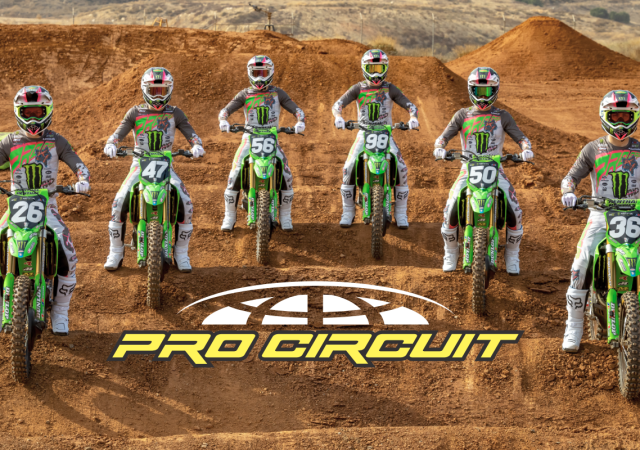
For this edition of Classic Steel, we are going to take a look back at Kawasaki’s all-new KX125 for 1994.
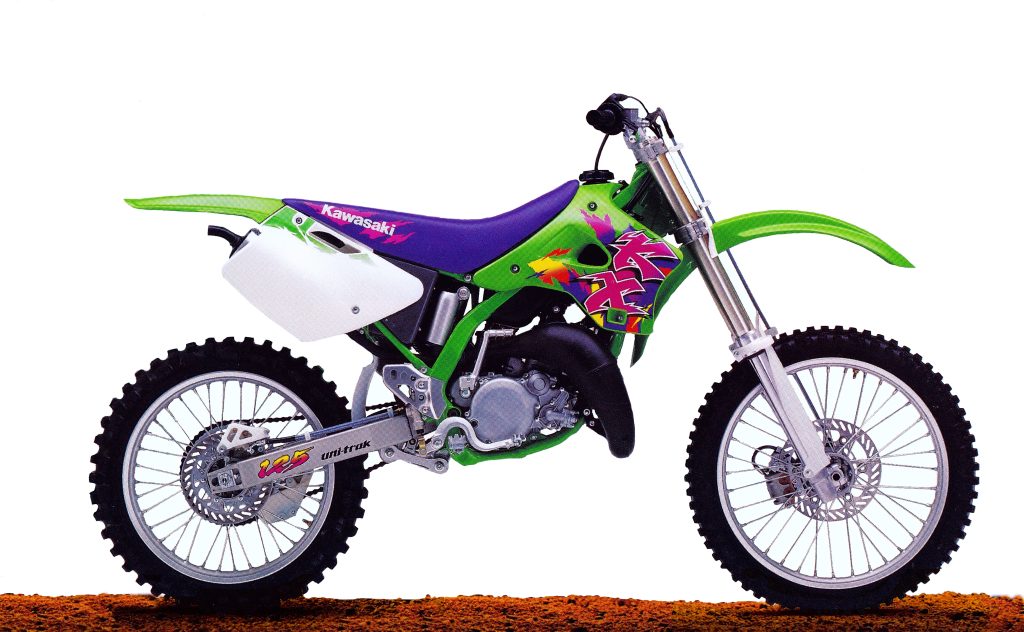 All-new from the ground up, Kawasaki’s KX125 was slimmer, sleeker, and suppler for 1994. Photo Credit: Kawasaki
All-new from the ground up, Kawasaki’s KX125 was slimmer, sleeker, and suppler for 1994. Photo Credit: Kawasaki
The 1993 season was a good year to be riding green in the 125 class. The KX125 was a great all-around machine with a broad powerband, great stability, and the best suspension in the class. It was not as fast and nimble as Honda’s blazing CR125R, but it was far better suspended, very stable, and an excellent overall machine. In the eyes of many, the KX125 offered the best overall 125 package available in 1993, but it was far from a unanimous decision. For those who found the KX less appealing, its deficiencies usually fell into three areas – size, braking, and reliability.
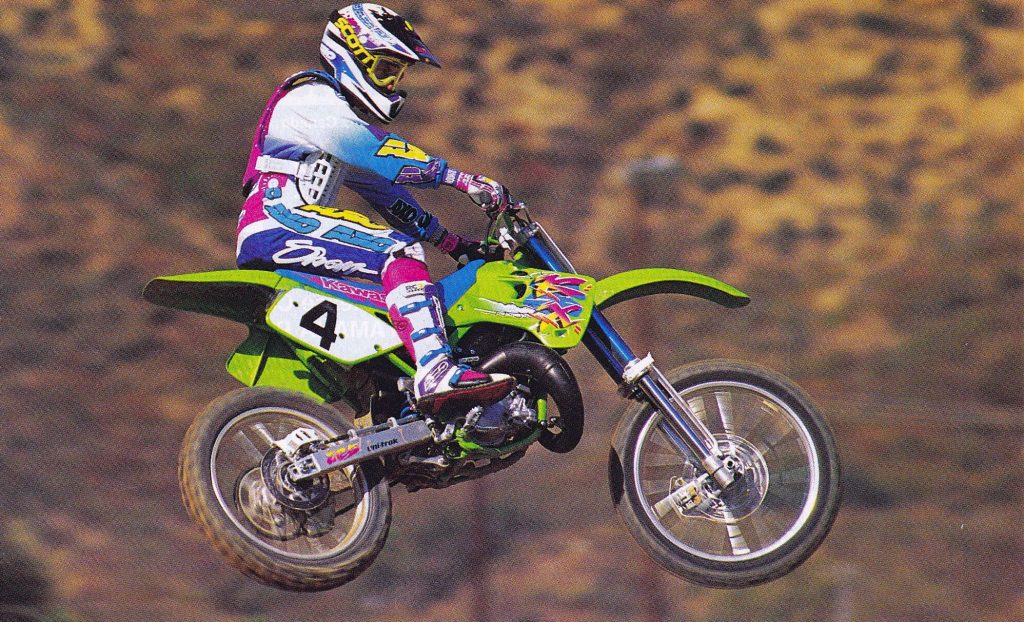 Picked by many as the best 125 of the year, the ’93 KX125 offered excellent suspension and broad power, but its fragile motor proved to be a black eye on an otherwise excellent package. Photo Credit: Karel Kramer
Picked by many as the best 125 of the year, the ’93 KX125 offered excellent suspension and broad power, but its fragile motor proved to be a black eye on an otherwise excellent package. Photo Credit: Karel Kramer
Ever since the introduction of the first perimeter-framed KX125 in 1990, the green tiddler had been a supersized machine. The KX’s state-of-the-art chassis provided a ton of strength, but it also made the bike feel much wider and taller than its 125 rivals. Compared to a nimble Honda or Suzuki 125, the KX felt more like an underpowered 250. This was not an issue for larger and taller pilots who appreciated the KX’s roomy layout, but many younger and smaller riders found the KX’s oversized proportions and big bike feel off-putting.
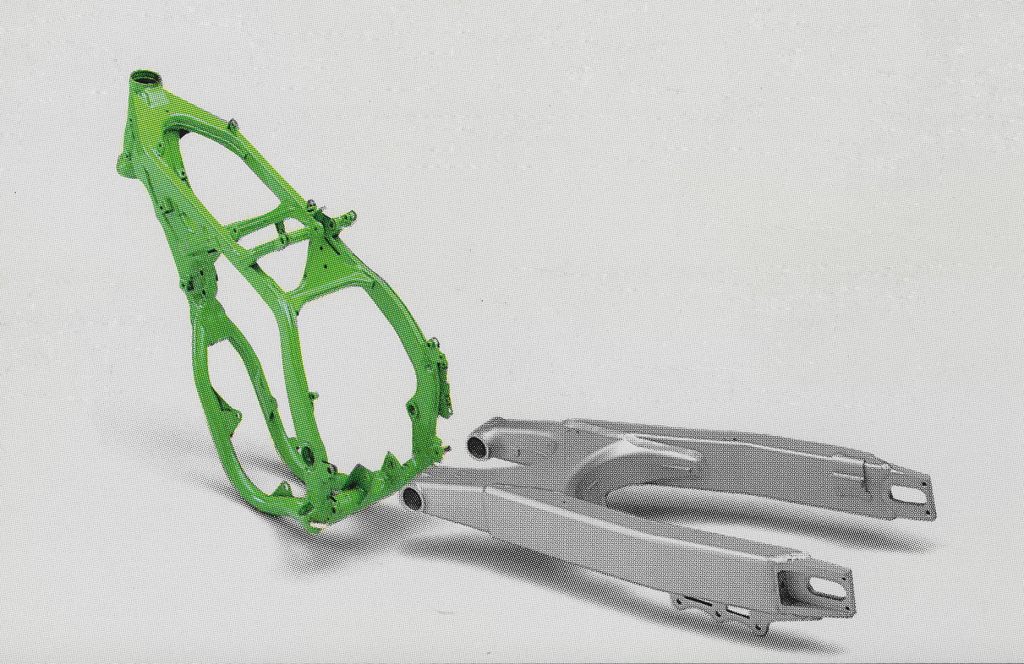 In 1994, Kawasaki shortened the wheelbase and downsized the chassis of the KX125. Photo Credit: Kawasaki
In 1994, Kawasaki shortened the wheelbase and downsized the chassis of the KX125. Photo Credit: Kawasaki
With the KX’s brakes most of the complaints centered around their lack of power and inconsistent feel at the lever. Constant bleeding was necessary to keep their action consistent and even once properly bled they lacked the firm and positive feel of its rivals. That soft and mushy feel at the lever never fully went away and many people felt it was the KX’s most significant deficiency in 1993.
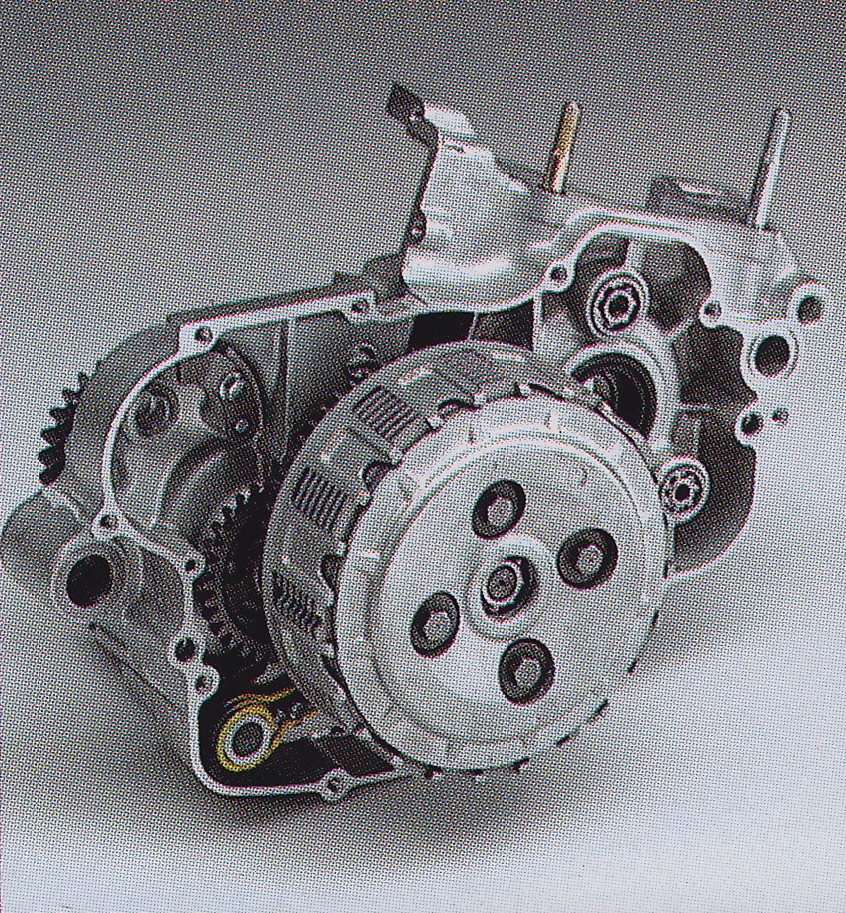 An all-new motor for 1994 upgraded the transmission and clutch and beefed up the top-end components to boost power and, hopefully, improve reliability. Photo Credit: Kawasaki
An all-new motor for 1994 upgraded the transmission and clutch and beefed up the top-end components to boost power and, hopefully, improve reliability. Photo Credit: Kawasaki
Last up on the KX’s list of demerits for 1993 was its rather annoying habit of grenading under hard use. When the motor ran, it was a real gem, with excellent snap down low, a strong midrange, and decent top-end pull, but that fun was often short-lived. The motor demanded race gas to keep detonation under control and if you neglected to feed it the good stuff your day could end with your sweet motor in many tiny pieces. Even if you ponied up for race gas, KX125s would often seize or fail at the crank for no apparent reason. It was a real black eye on an otherwise excellent motor package. Despite these shortcomings, however, the KX125 remained one of the most competitive machines in the 125 class, taking home victories in both MXA and Dirt Bike’s 125 shootouts in 1993.
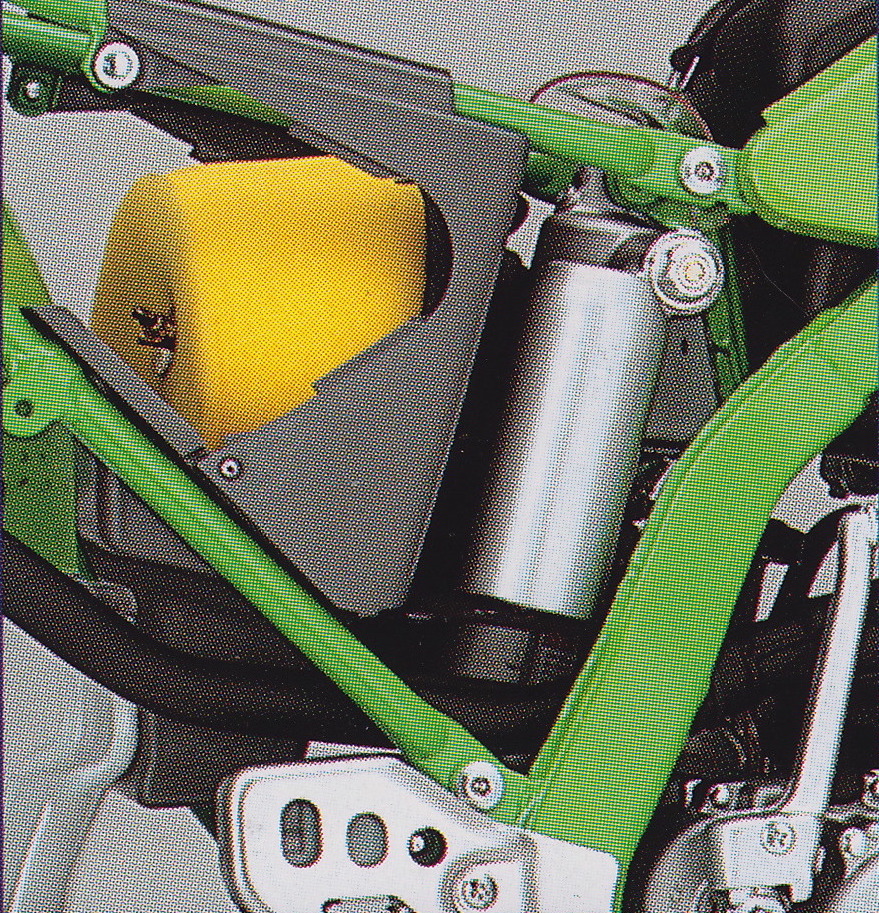 A redesigned airbox for 1994 provided a narrower profile and easier access to the filter. Photo Credit: Kawasaki
A redesigned airbox for 1994 provided a narrower profile and easier access to the filter. Photo Credit: Kawasaki
While the KX’s deficiencies were not enough to sink its fortunes in the magazine shootouts in 1993, Kawasaki was well aware that they would need to step up their game if they hoped to retain their 125 crown in 1994. With that in mind, Kawasaki dialed up an all-new and hopefully improved KX125 for 1994.
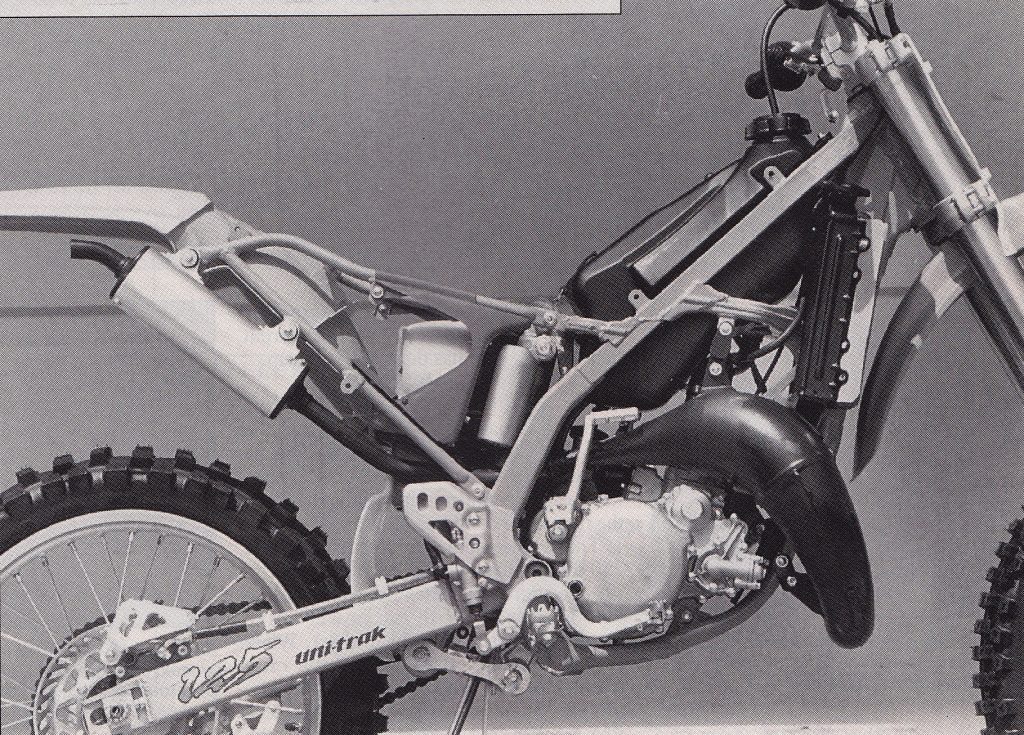 In 1994, Kawasaki’s goal for the KX chassis was to improve turning and reduce its oversized proportions. The new frame was more compact and significantly narrower, helping to alleviate many of the complaints riders had voiced with the large-feeling 1990-1993 KX frames. Photo Credit: Kawasaki
In 1994, Kawasaki’s goal for the KX chassis was to improve turning and reduce its oversized proportions. The new frame was more compact and significantly narrower, helping to alleviate many of the complaints riders had voiced with the large-feeling 1990-1993 KX frames. Photo Credit: Kawasaki
First up was an all-new chassis that was stronger, shorter, and more compact. The new frame retained the perimeter steel design of the previous generation but shortened the wheelbase by half an inch and narrowed the frame spars to give the machine a slimmer feel. The steering head was repositioned, and the geometry was altered to be slacker by 0.5 degrees. The subframe was moved from aluminum to steel and additional gusseting was added throughout to reduce chassis flex. The Uni-Trak linkage was completely redesigned and the swingarm was updated to be lighter, stronger, and more compact. All-new brakes for 1994 looked to drive out the mush by redesigning the master cylinders front and rear, upping the pad grip, beefing up the levers, replacing the hydraulic lines, and stiffening the calipers.
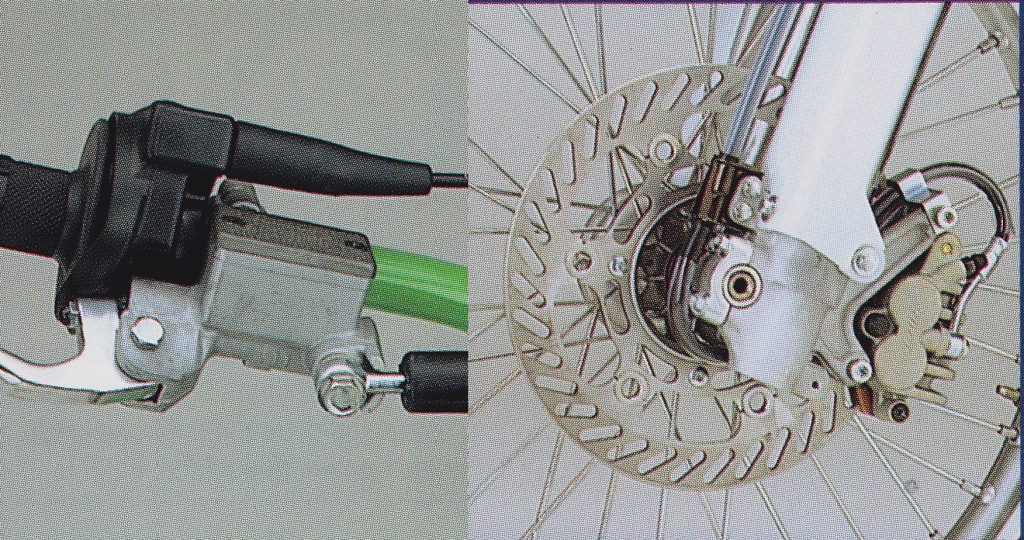 In 1993, one of the major complaints with the KX was its underpowered brakes. For 1994, Kawasaki stole the caliper off their off-road KLX650 and redesigned the master cylinder to reduce lever travel and provide a firmer feel. Photo Credit: Kawasaki
In 1993, one of the major complaints with the KX was its underpowered brakes. For 1994, Kawasaki stole the caliper off their off-road KLX650 and redesigned the master cylinder to reduce lever travel and provide a firmer feel. Photo Credit: Kawasaki
Up front, the KX retained the excellent 43mm Kayaba inverted forks that had won rave reviews in 1993. Updates for 1994 included a new slippery Teflon coating for the tubes to reduce stiction, stiffer springs, and revised damping. To protect the new forks and their fancy coating, Kawasaki moved to a wrap-around fork guard in 1994. Travel was set at 12.2 inches with 16 selectable settings for compression and rebound damping.
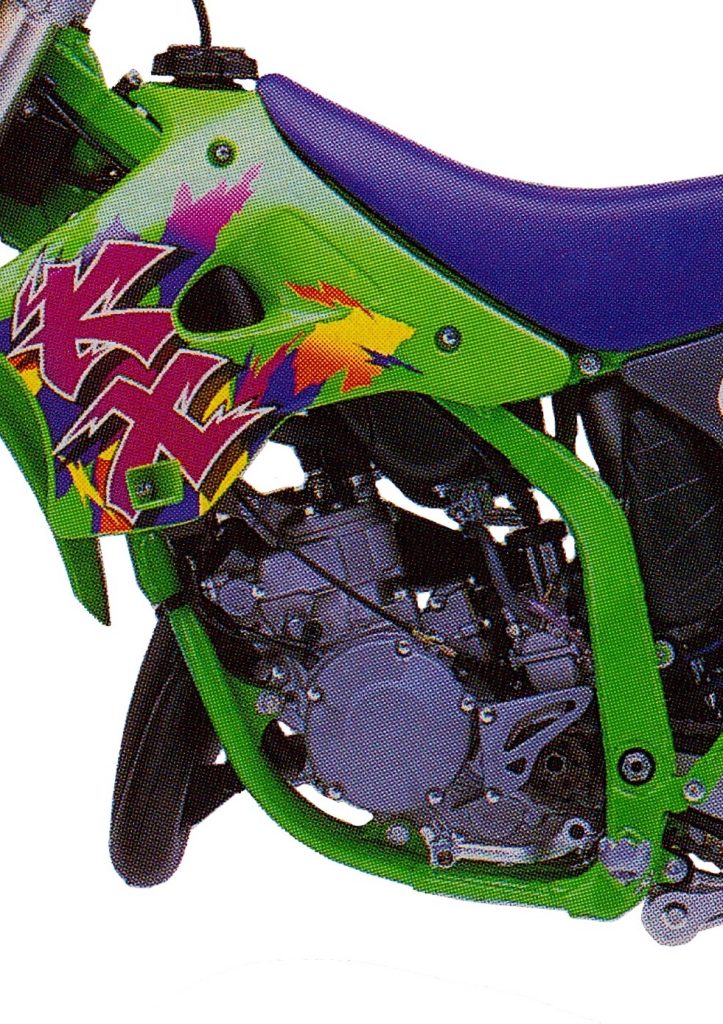 In 1993, the KX125 motor had been fragile but it ran excellently with one of the sweetest powerbands in the class. In 1994, Kawasaki changed everything and ended up with a more reliable but significantly less potent mill. In stock condition, the motor was choked off, prone to bogging, and saddled with an annoying pop on top. Opening up the airbox, rejetting, and venting the carb helped alleviate the bog and pop but the old motor’s broad power was DOA without investing in serious motor work. Photo Credit: Kawasaki
In 1993, the KX125 motor had been fragile but it ran excellently with one of the sweetest powerbands in the class. In 1994, Kawasaki changed everything and ended up with a more reliable but significantly less potent mill. In stock condition, the motor was choked off, prone to bogging, and saddled with an annoying pop on top. Opening up the airbox, rejetting, and venting the carb helped alleviate the bog and pop but the old motor’s broad power was DOA without investing in serious motor work. Photo Credit: Kawasaki
In the rear, Kayaba was once again the supplier with an all-new shock added to work with the redesigned frame and updated Uni-Trak linkage. The revised damper featured a 0.2 kg/mm stiffer spring for 1994 and a revised compression damping system with a 4mm larger valve and all-new settings. Overall travel was set at 13.0” with 16 available settings for compression and rebound adjustment.
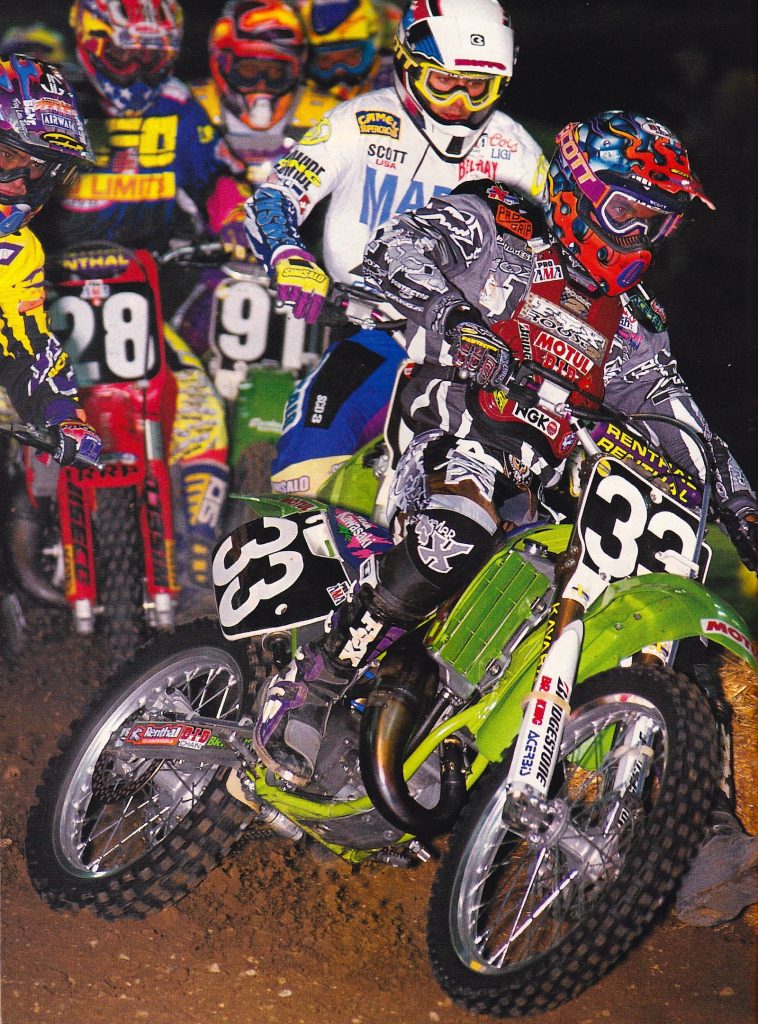 In 1994, Robbie Reynard was factory Kawasaki’s top gun on the KX125. An amateur phenom, Reynard showed tremendous speed on the KX but was never able to put it all together for a major 125 title. In 1994, Robbie raced the all-new KX125 to three podiums and a season-ending victory at Steel City. Photo Credit: Chris Hultner
In 1994, Robbie Reynard was factory Kawasaki’s top gun on the KX125. An amateur phenom, Reynard showed tremendous speed on the KX but was never able to put it all together for a major 125 title. In 1994, Robbie raced the all-new KX125 to three podiums and a season-ending victory at Steel City. Photo Credit: Chris Hultner
Paired with the revamped chassis was all-new bodywork that improved ergonomics and updated the KX’s looks considerably. The shrouds, seat, number plates, rear fender, airbox, and fork guards were all-new with only the front fender as a carryover from the year before. The new pilot’s compartment was considerably slimmer and more compact for ’94 with a flatter and lower seat featuring dual-density foam and an updated footpeg and bar placement. New handholds molded into the side plates made the bike easier to haul onto the stand and all-new graphics graced the seat and shrouds. At the time the updated looks were roundly praised, and most riders seemed to feel it was an upgrade over the 1993.
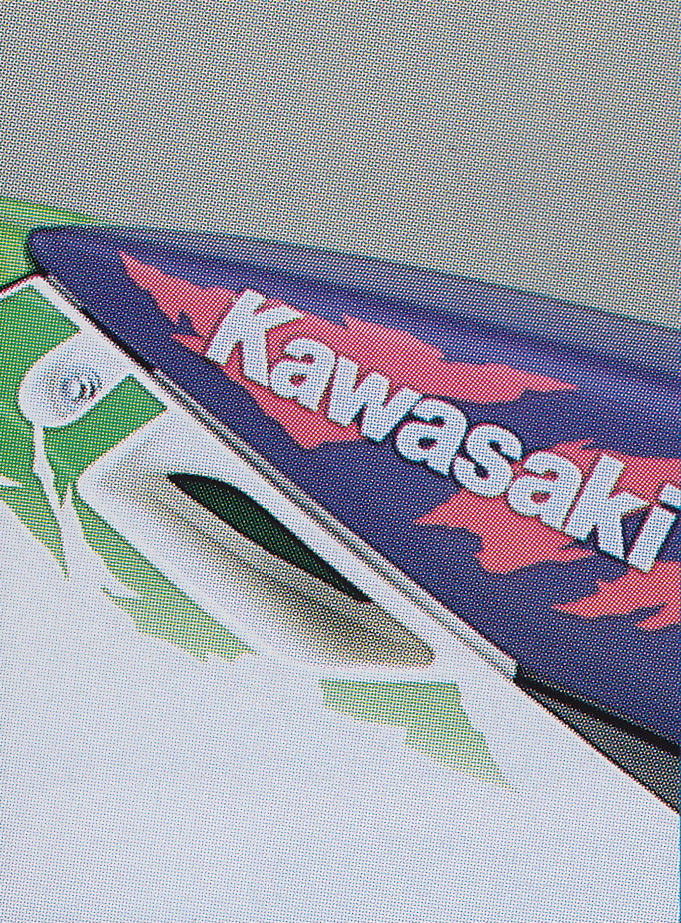 The new handholds molded into the side plates were a welcome addition for 1994 but tuners found that the small openings restricted airflow to the KX’s redesigned airbox. To get the most out of the new motor it was necessary to enlarge the holes slightly, trim the seat base, and make some modifications to the splash shield in front of the airbox opening. Photo Credit: Kawasaki
The new handholds molded into the side plates were a welcome addition for 1994 but tuners found that the small openings restricted airflow to the KX’s redesigned airbox. To get the most out of the new motor it was necessary to enlarge the holes slightly, trim the seat base, and make some modifications to the splash shield in front of the airbox opening. Photo Credit: Kawasaki
On the motor front, Kawasaki dialed up an all-new powerplant for ’94. Everything from the top end to the lower cases was revamped with changes aimed at boosting power and improving reliability. The new cylinder featured revised porting and updates to the KIPS (Kawasaki Integrated Power-valve System) designed to boost low-to-mid response. The rod was redesigned and featured a smaller wrist pin and lighter construction for quicker response. A new piston was added with a stronger skirt and a 1.4-gram heavier construction. The intake was reduced in size by 18% and the reed valve was moved from a six-pedal to a four-pedal design to increase intake velocity. The material of the reeds was changed from carbon fiber to epoxy resin to alleviate the chipping issues the stock reeds had suffered from the year before. The carburetor remained a 36mm Keihin PKW design but featured a smaller manifold on the intake side for increased air velocity. An all-new airbox for 1994 offered a narrower profile through the middle of the machine, a smaller air filter element, and an 18% increase in airflow to the air cleaner. An all-new expansion chamber was added to work with the reconfigured top end and featured a 50mm shorter silencer for improved performance. The ignition was all-new as well and featured revised timing to optimize spark control for a cleaner burn. Cooling was improved by reducing the number of hoses and increasing the velocity of the coolant throughout the system.
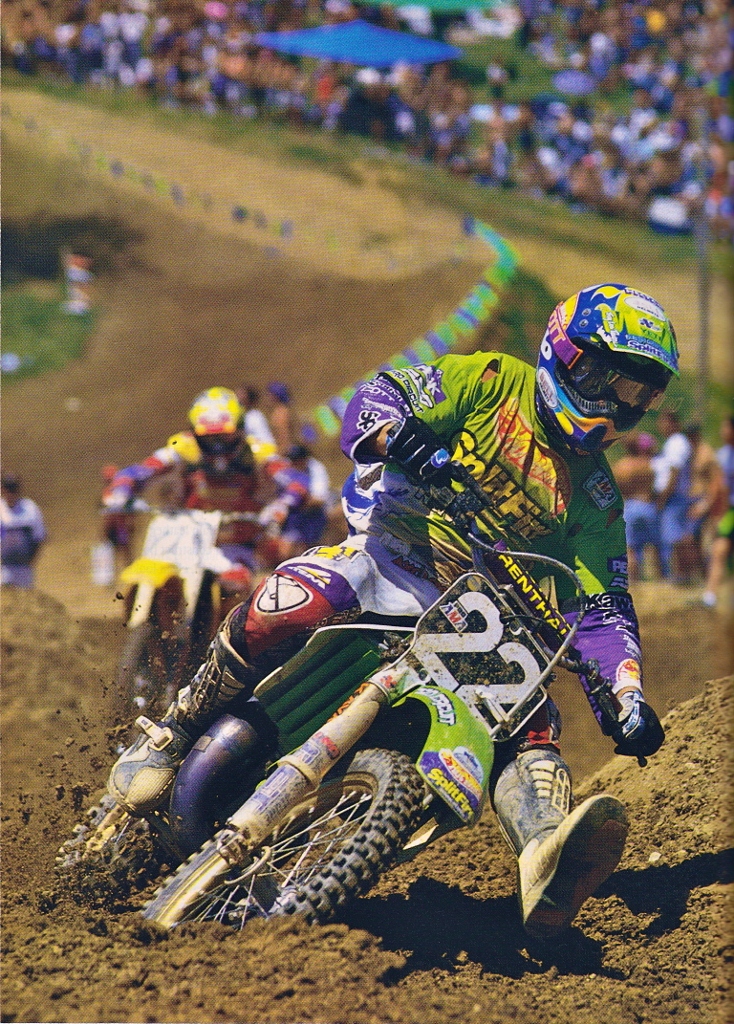 Pro Circuit Kawasaki had a strong team on the redesigned KX125 in 1994. Team leader Ryan Hughes raced the KX to three victories indoors and two more in the great outdoors on his way to third overall in the motocross standings. Photo Credit: Motocross Action
Pro Circuit Kawasaki had a strong team on the redesigned KX125 in 1994. Team leader Ryan Hughes raced the KX to three victories indoors and two more in the great outdoors on his way to third overall in the motocross standings. Photo Credit: Motocross Action
In the bottom end, an all-new clutch and transmission improved shifting, optimized power delivery, and increased durability. The new clutch was 10mm larger in diameter, rotated slower, and featured one less plate than in 1993. The primary reduction ratio from the crankshaft to the clutch was reduced from 3.5:1 to 3.2:1 to reduce the torque load on the clutch for improved durability. The transmission ratios were all-new with a lower first and slightly wider ratios for second through sixth. A new shift drum was added that rode on needle bearings and the transmission shafts were relocated 2mm farther apart to allow for larger beefed-up gears. Both the shift forks and shaft were also enlarged for improved reliability.
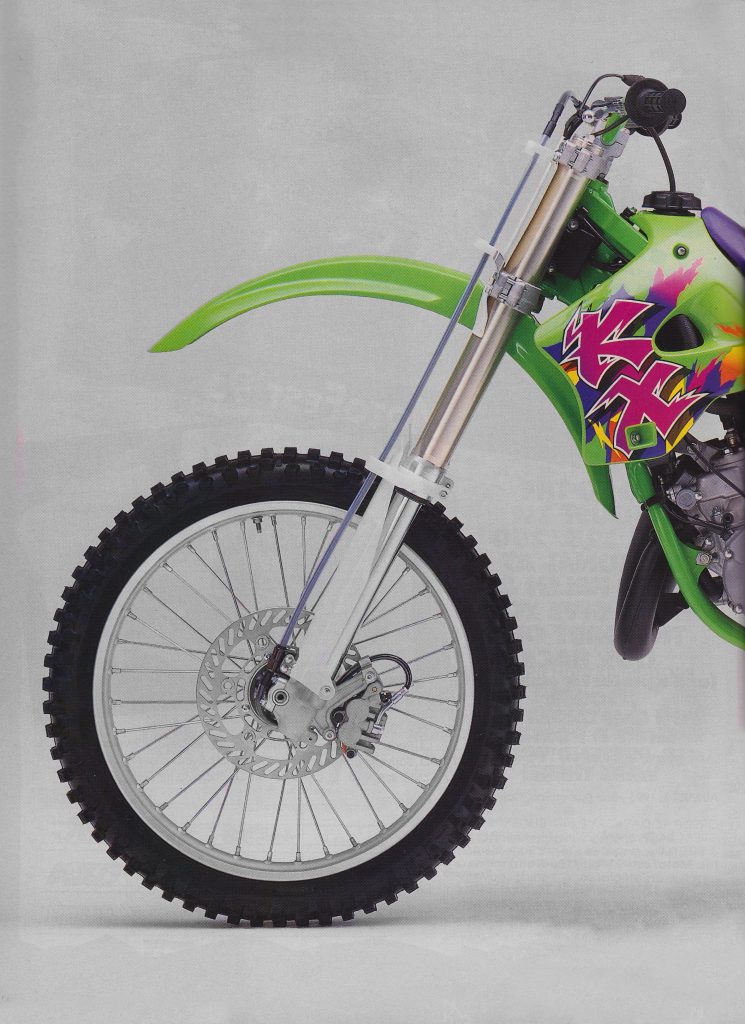 In the early 1990s Kawasaki’s greatest advantage over its competitors was its excellent suspension. The KX’s 43mm inverted Kayaba forks were incredibly plush and well-sorted. Nothing on the track was as smooth and comfortable in the rough as the KX in 1994. Photo Credit: Kawasaki
In the early 1990s Kawasaki’s greatest advantage over its competitors was its excellent suspension. The KX’s 43mm inverted Kayaba forks were incredibly plush and well-sorted. Nothing on the track was as smooth and comfortable in the rough as the KX in 1994. Photo Credit: Kawasaki
On the track, the all-new KX125 turned out to be a significant improvement in some areas but a step backward in others. First up on the improved list was the new chassis which offered much more accurate turning without sacrificing the previous KX’s excellent stability. The slimmer midsection, flatter seat, and more compact layout helped give the KX a lighter feel that was apparent both on the ground and in the air. The bike could be tossed around with ease and was an excellent jumper. It was still not as effortless in the turns as the CR125R and RM125, but the new chassis was far nimbler than in the past while still being rock solid at speed.
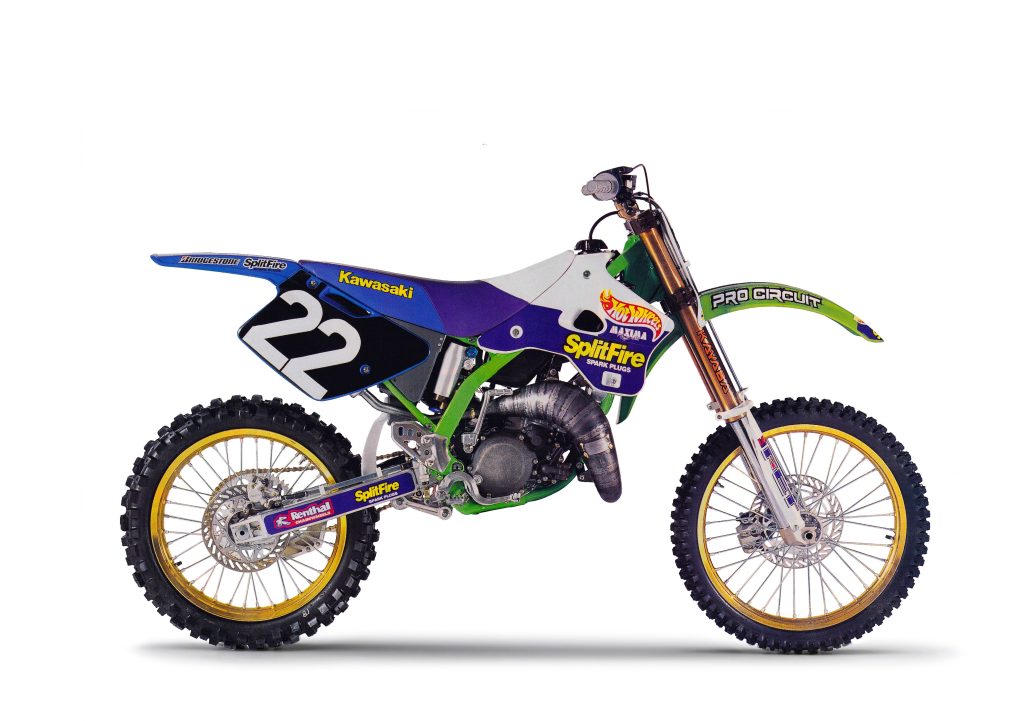 While the stock KX125 was no powerhouse, Mitch Payton and Pro Circuit found a way to bring out its full potential and put the green machines at the front in 1994. Photo Credit: Motocross Action
While the stock KX125 was no powerhouse, Mitch Payton and Pro Circuit found a way to bring out its full potential and put the green machines at the front in 1994. Photo Credit: Motocross Action
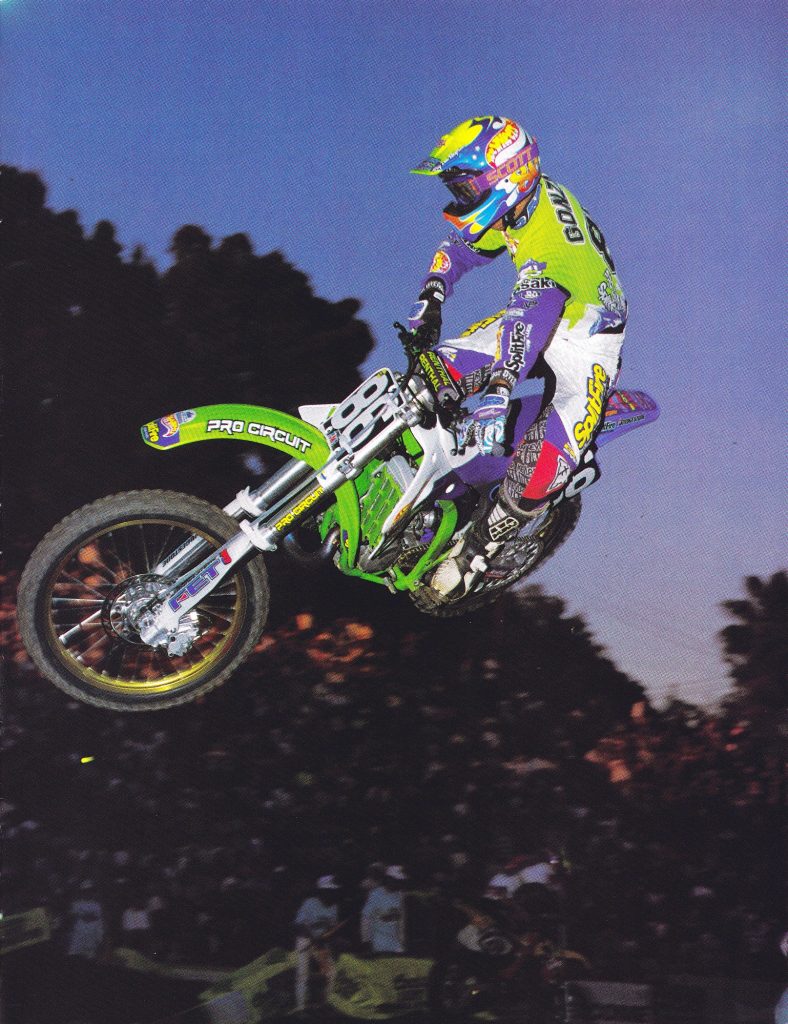 Pedro Gonzalez surprised many on his Hot Wheels Pro Circuit KX125 in 1994, taking three podiums and a very popular win at San Diego on his way to second overall in the 125 West Coast series. Photo Credit: Kinney Jones
Pedro Gonzalez surprised many on his Hot Wheels Pro Circuit KX125 in 1994, taking three podiums and a very popular win at San Diego on his way to second overall in the 125 West Coast series. Photo Credit: Kinney Jones
The suspension upgrades for 1994 offered a bit more bottoming resistance while still maintaining the ultra-plush feel that testers praised in 1993. Both the forks and shock were well-damped and super comfortable on the track. Bumps that beat the wrists and backsides of riders on the CR were gobbled up without a care on the KX. Riders from novices to pros praised their smooth action and nothing else was close to their performance in 1994. Most riders could find a comfortable setting by playing with the oil level and spinning the clickers. Really fast guys still needed stiffer springs, but for 95% of the riders likely to race a 125 it was a spectacular suspension package.
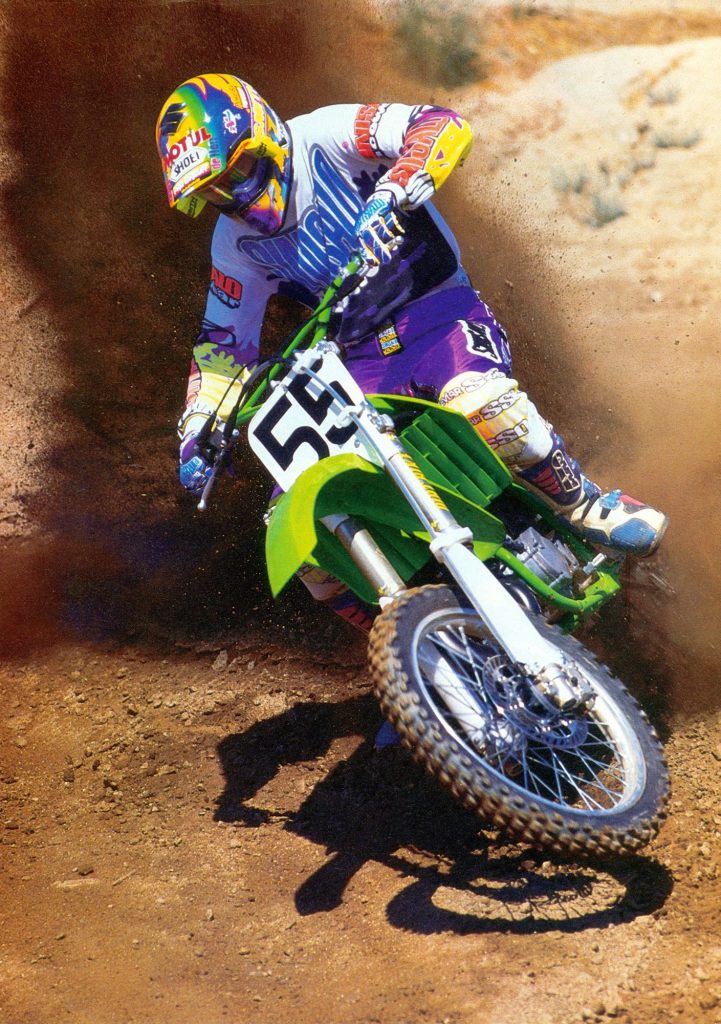 Once the KX’s airbox was opened up the machine delivered a punchy but narrow spread of power that was competitive but much harder to use than the year before. When it was on the pipe the green machine was fast, but that burst was short-lived and the KX preferred to be shifted rather than revved to the moon. Photo Credit: Dirt Bike
Once the KX’s airbox was opened up the machine delivered a punchy but narrow spread of power that was competitive but much harder to use than the year before. When it was on the pipe the green machine was fast, but that burst was short-lived and the KX preferred to be shifted rather than revved to the moon. Photo Credit: Dirt Bike
Last up on the significant upgrade list for 1994 was the KX’s new brakes. The upgraded master cylinders, rotors, calipers, and lines delivered a much-improved feel and increased bite. The front brake no longer went all the way to the bars before engaging and offered competitive power for the first time in years. It was still not as firm and powerful as the Honda’s Nissin components but the performance gap between the KX and its rivals was no longer a massive canyon. The rear was very powerful, but some riders felt its engagement was a bit grabby with the new components. To keep the action consistent, it was best to bleed them once a month and run a high-quality fluid like Motul 300c. For most riders, the stock brakes were plenty good enough to race with and a huge improvement over the year before.
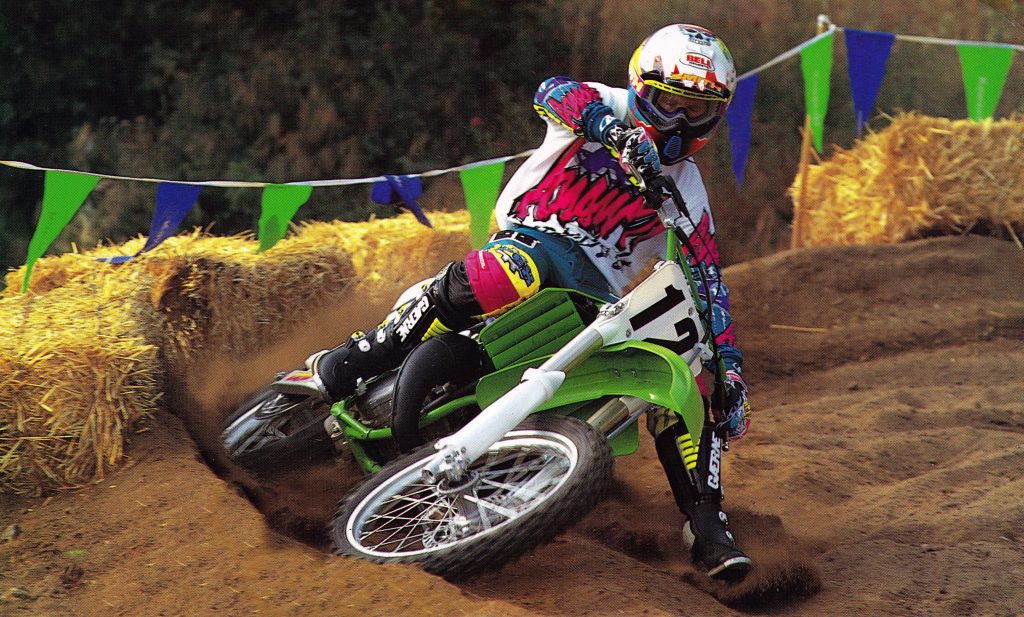 Overall handling was much improved for 1994 with much sharper turning from the slimmed-down KX chassis. Photo Credit: Kawasaki
Overall handling was much improved for 1994 with much sharper turning from the slimmed-down KX chassis. Photo Credit: Kawasaki
Where things took a turn for the new KX was in the motor department. After the reliability debacle in ’93 Kawasaki was very concerned with making their KX125 more reliable and on that front, they mostly succeeded. The new motor was much less fragile than in ’93, but new KX125 owners were advised by Kawasaki to run race gas in their ‘94s. This was something that raised eyebrows at the time. It was no secret that the KX125 had needed race gas to survive the year before, but it was odd for an OEM to advise its use out of the crate. Perhaps this was just a precaution, but it was a bit disconcerting to many.
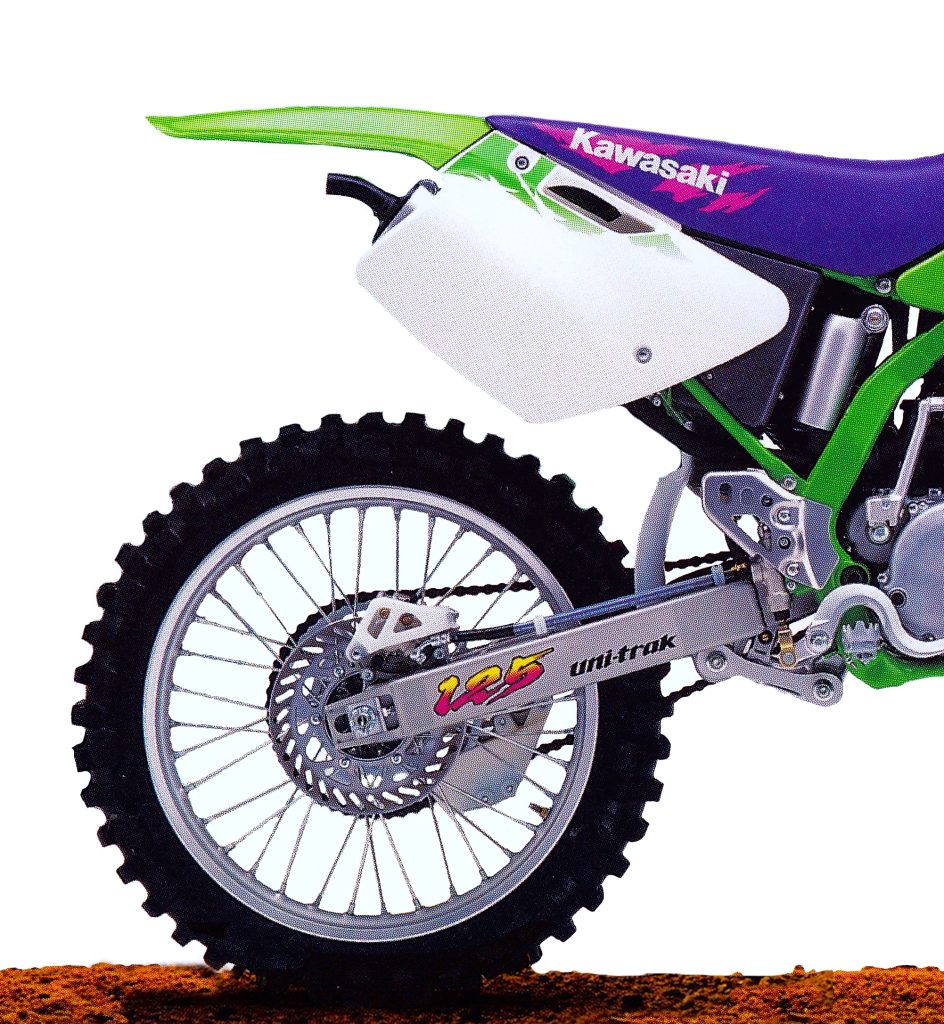 The KX’s KYB shock was praised every bit as much as its forks and riders of all skill levels found its action to be plush and well-controlled. Photo Credit: Kawasaki
The KX’s KYB shock was praised every bit as much as its forks and riders of all skill levels found its action to be plush and well-controlled. Photo Credit: Kawasaki
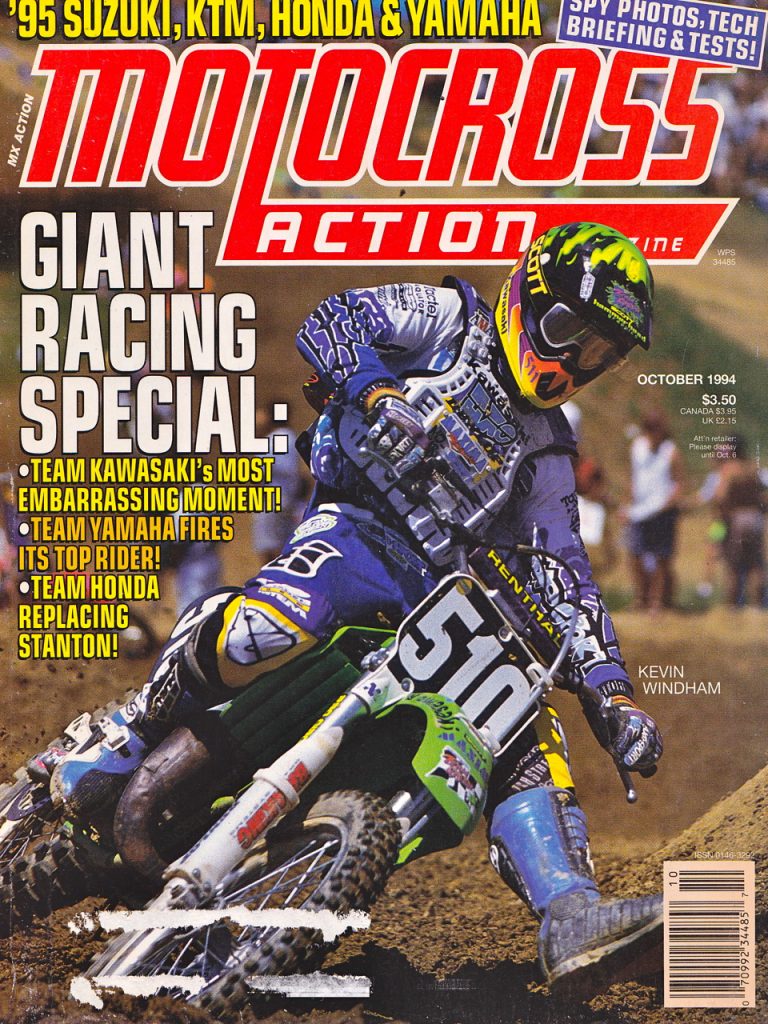 One of the most surprising moments of the year on the all-new KX125 turned out to be the performance of a rather unknown amateur from Louisiana by the name of Kevin Windham. At High Point, Windham shot out to an early lead on his number 510 Kawasaki and held on to the pole position for most of the first moto before giving way to Doug Henry late in the moto. At the end of the day, Windham held on for fifth overall and made the cover of Motocross Action.
One of the most surprising moments of the year on the all-new KX125 turned out to be the performance of a rather unknown amateur from Louisiana by the name of Kevin Windham. At High Point, Windham shot out to an early lead on his number 510 Kawasaki and held on to the pole position for most of the first moto before giving way to Doug Henry late in the moto. At the end of the day, Windham held on for fifth overall and made the cover of Motocross Action.
In terms of performance, the new motor turned out to be a disappointment in most respects. In stock condition, the motor was soft off the bottom, punchy in the midrange, and mediocre on top. There was significantly less low-end torque than in 1993 and the bike was far more difficult to keep on the pipe. The new motor did stay together much better than in the past, but the green team seemed to be trading power for reliability. The updated motor was both slower and harder to ride than the year before and several riders complained of bogging down low and popping on top.
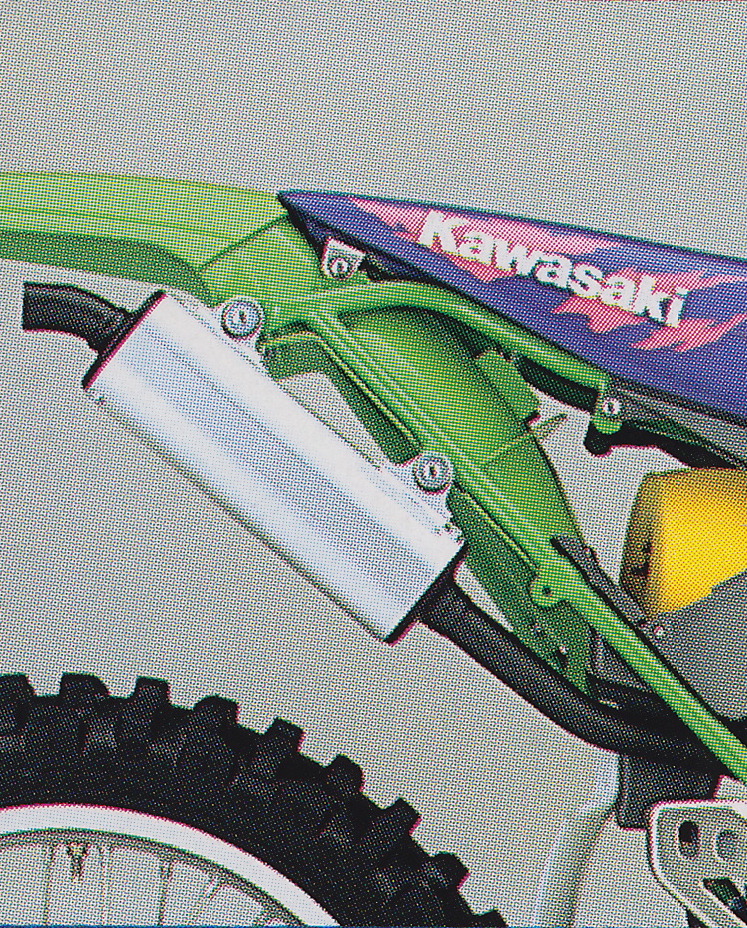 An all-new silencer for 1994 was 50mm shorter. Photo Credit: Kawasaki
An all-new silencer for 1994 was 50mm shorter. Photo Credit: Kawasaki
Some of the culprits for the lost power and poor performance seemed to be the new bodywork which tuners discovered was choking off the air to the motor. The quickest fix for this asthmatic issue was to trim the plastic around the side plate hand holds, shave down the ribs molded into the seat base, and open up some holes in the plastic splash guard located between the tank and airbox. The carburetor also had issues with vapor locking due to fuel backing up into the overflow tubes. The easy fix for this was to purchase a set of T-vents from Pro Circuit and route two additional lines under the tank. Once these modifications were done and the carb was rejetted the KX’s performance improved noticeably. The bike picked up better off the bottom, stopped bogging in the whoops, and did not go as flat on top. It was still a far cry from the fire-breathing Honda but at least it no longer popped, bogged, and wheezed around the track.
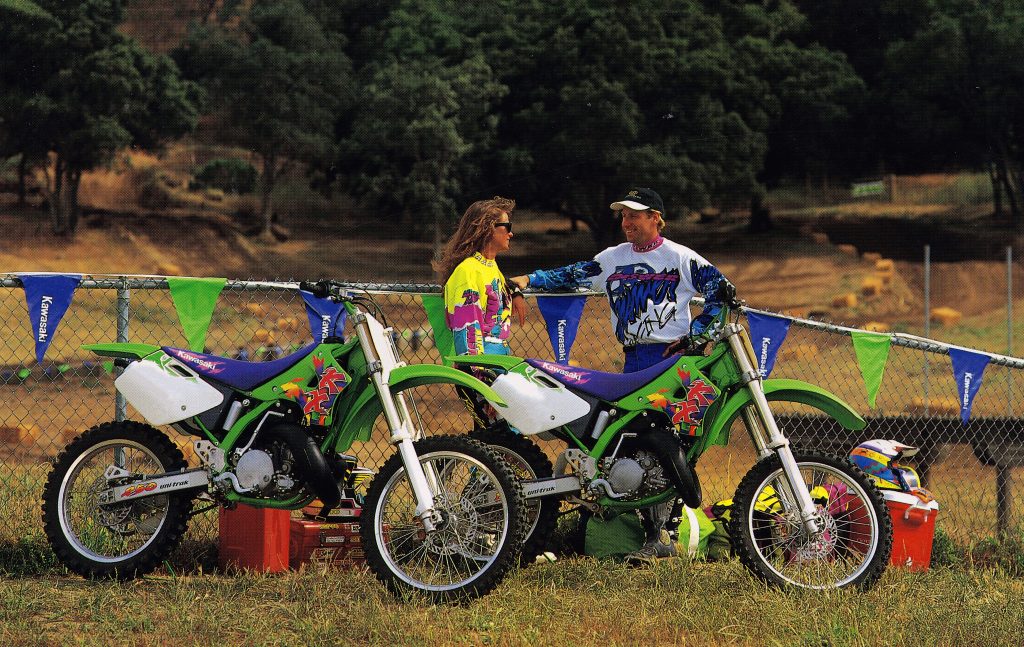 The all-new KX125 and KX250 were easily two of the best-looking machines of 1994 Photo Credit: Kawasaki
The all-new KX125 and KX250 were easily two of the best-looking machines of 1994 Photo Credit: Kawasaki
On the detailing front, the KX125 was quite a mixed bag in 1994. The new steel subframe was sturdy and finally put an end to the stripped seat and fender mounts that had plagued KX owners for years. Updated bodywork and graphics were great looking and the ergonomics were super comfortable. Unless you were Herman Munster, the downsized layout for 1994 was a welcome improvement. The huge footpegs were still the most comfortable in the class but their return springs broke regularly and cracks at the mounting points were common. It was a good idea to keep a close eye on these welds lest you find yourself pulling a one-footer on a hard landing. The stock triple clamps were also known to crack if improperly torqued and the easiest fix was to swap them for the less fragile 1993 clamps. The stock exhaust also frequently cracked at the first weld. Switching to a Pro Circuit or FMF pipe avoided this problem and did a good job of waking up the sleepy top end.
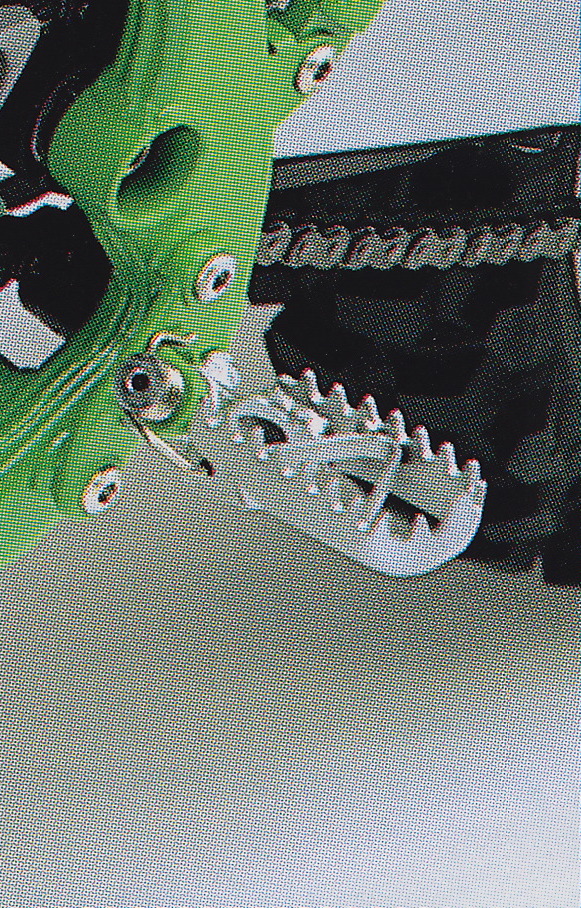 Kawasaki’s large platform pegs were loved for their comfort, but it was wise to keep an eye on the fragile return springs and crack-prone mountings. Photo Credit: Kawasaki
Kawasaki’s large platform pegs were loved for their comfort, but it was wise to keep an eye on the fragile return springs and crack-prone mountings. Photo Credit: Kawasaki
The revamped motor was no powerhouse, but it did hold together much better than the year before. You could get away with a 50/50 mix of pump and race gas and as long as you opened up the airbox, popped for a set of T-vents, rejetted the carb, and used good oil, it ran decently and kept in one piece. The new gearbox was an improvement over previous Kawasaki efforts, but it remained more notchy than the Honda and Suzuki cogboxes. The revamped clutch offered a light pull and proved durable, but it did get a bit grabby if hammered. Unfortunately, hammering it was pretty much a necessity due to the motor’s narrow powerband.
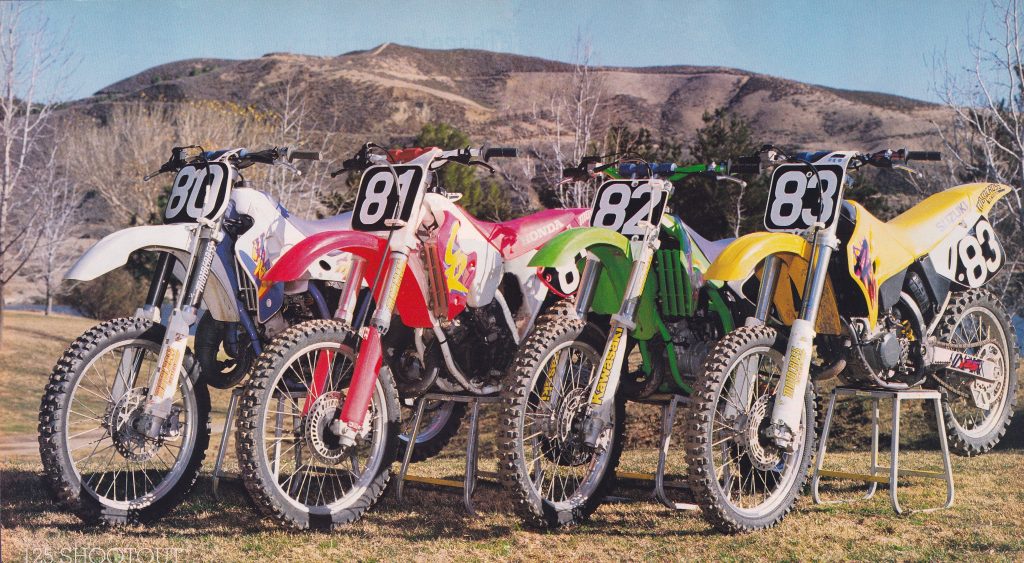 The 1994 season was a good one for 125 performance. All the bikes had their devotees, but most racers felt the power of the Honda and the do-it-all competence of the RM ruled the day over the Kawasaki’s excellent suspension. Photo Credit: Motocross Action
The 1994 season was a good one for 125 performance. All the bikes had their devotees, but most racers felt the power of the Honda and the do-it-all competence of the RM ruled the day over the Kawasaki’s excellent suspension. Photo Credit: Motocross Action
In the end, the 1994 Kawasaki KX125 proved to be a frustrating follow-up to a class-leading machine. Its new chassis, bodywork, and suspension were all at the top of the class, but its revamped motor proved to be a death blow to an otherwise excellent 125 package. The new motor was more reliable, but it lacked the excellent power of the year before. If Kawasaki had kept the old motor and just improved the reliability, they would have had the best 125 of 1994, but as it was, they had an excellent machine in every way but the one that counted most.
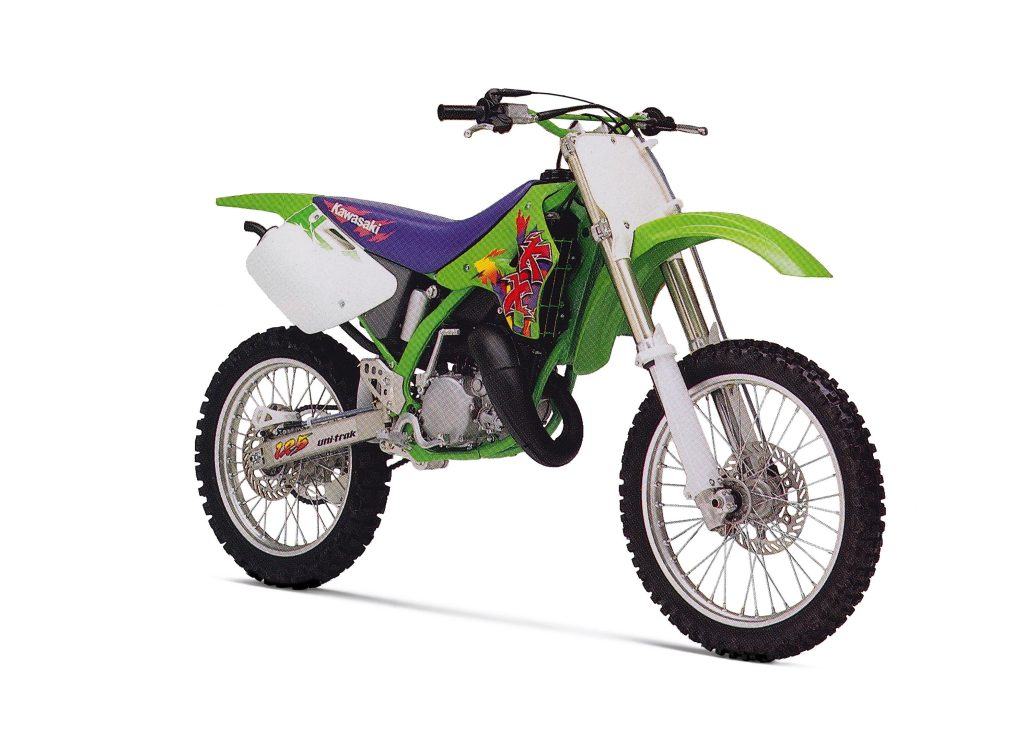 The 1994 Kawasaki KX125 had a lot going for it, but its one major flaw was hard to overlook. Good handling, supple suspension, and snazzy looks won it a lot of fans, but its narrow powerband held it back from being the four-quadrant crowd-pleaser it was the year before. Phot Credit: Kawasaki
The 1994 Kawasaki KX125 had a lot going for it, but its one major flaw was hard to overlook. Good handling, supple suspension, and snazzy looks won it a lot of fans, but its narrow powerband held it back from being the four-quadrant crowd-pleaser it was the year before. Phot Credit: Kawasaki




